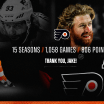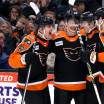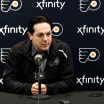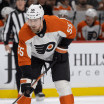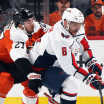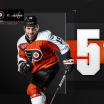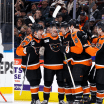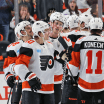One season ago, major improvement by the Flyers' penalty kill -- as well as team defense as a whole and overall performance by the goaltenders because all these factors are interrelated -- was a key driving factor in the team's surge in the standings.
Flyers PK: What's Needed to Get Back on Track?
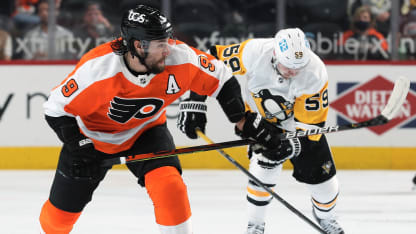
After ranking 26th in the NHL with a 78.6 percent success in 2018-19, the team improved to 81.8 percent in 2019-20 to rank 11th. While there was still room for improvement, it was the Flyers' high-water mark for a season, both in success rate and leagewide ranking since the team killed penalties at an 84.3 percent clip in 2013-14 to rank seventh leaguewide. Only three times in that span (an 80.5 percent rate in 2015-16 being the other time) have the Flyers reached even the 80 percent mark on the PK for a season.
Unfortunately, the Flyers' penalty kill took a major backward step in 2020-21. The club's 73.1 percent success rate ranked 30th among the 31 teams in the NHL. Except for two separate spells in which the team went 12-for-13, the PK was a sore spot virtually the entire season. This was part of the bigger-picture problems the Flyers had with team defensive struggles and an overall disappointing year in net. The Flyers ranked last in the NHL in both goals against average (3.52 GAA) and team save percentage across all manpower situations.
Personnel losses hurt. The Flyers felt the loss of Matt Niskanen's all-situation minutes, including the penalty kill. To a lesser extent, they also felt the loss of forward Tyler Pitlick, who averaged 1:03 of PK ice time (sixth among all Flyers forwards who dressed in 20 or more games in 2019-20). Neither player was adequately replaced in the PK rotation.
Goaltending was another factor. However, this is a double-edged sword. It's fair to say that the play in front of the goalies made life exceptionally tough on the netminders at times as well as some potentially makeable saves ending up in the net hurting the PK as a whole. Both aspects came into play at different times.
The bottom line was this:Across the entire NHL in 2020-21, 47 goalies appeared in at least 20 games. The median save percentage on penalty kills among these goalies was .865 in 2020-21 after it was .867 on average in 2019-20. Among the Flyers' goalies, Carter Hart stopped just .783 of the shots on goal he faced on the PK this season (ranking last among all NHL goalies with 20 or more GP this season). Brian Elliott ranked 30th at an .856 PK save percentage. The Flyers allowed 23 opposing PPG with Hart in net, and 15 with Elliott.
In terms of the play in front of the Flyers' goalies, it's fair to say that there were many penalty killing regulars who individually did not perform as well in 2020-21 as they did the previous season. This includes the likes of 2019-20 Selke Trophy winner Sean Couturier, Kevin Hayes, Ivan Provorov and Travis Sanheim, among others. Penalty killing, however, is really about what's going on collectively more than individually.
As four-man units (or three-man units when necessary), the Flyers' penalty killers were just not nearly as consistent in their execution as they were in 2019-20. Specific problem areas included, but were not limited to: 1) entry denials, 2) rate of clearing opportunities versus successful clears, 3) generating strong-side puck pressure, 4) denying cross-seam passes, 5) ragging significant time off the clock after puck possession was gained, 6) generating and finishing off shorthanded transition opportunities, 7) turning successful penalty kills into momentum-changers within a period.
Flyers assistant coach Mike Yeo, who is in charge of the defense and penalty kill, was recently a guest on Jason Myrtetus' "Flyers Daily" podcast on the Flyers' Broadcast Network. Yeo addressed a variety of overarching issues from this past season; not exclusive to the penalty killing struggles but which also pertained to the PK.
"That's our job to have the players ready; to have them focused and to have them go out and execute," Yeo said of the coaching component of preparation and adjustment.
"I can assure you that no one on our coaching staff is saying, 'Well, we just didn't have much control. It's not our fault.' We're all taking it very personally. That [feeling] sucks but, at the same time, I know it will be fuel for everybody. For myself personally, it's to do whatever I can to make sure we don't feel this way again at the same time next year."
Yeo feels that the Flyers, collectively, struggled to correct the fractional areas of attention-to-detail that separate a successful team defense (including the penalty kill) from one that ranks on the bottom end of the league.
"Instinct versus. thought: The difference is split seconds but it's a massive difference when you get into games. When a player has to process and think on the ice, you play slower. When you play slower, you get caught in between," Yeo said.
"So, for example, instead of a defenseman being right on top of the guy when he's pinching, you're just a little late in arriving. Or a forward, instead of being on top of their F3 or covering up for their defensemen when they're pinching, that's where the big breakdowns happen. You can have all the systems you want. What really separates one system from another is the details of [executing] that system.
"That's where I noticed a big difference this season. You can have a D zone coverage where you're in good position but if you don't have your stick in the right position -- if you don't go stick-on-puck -- you won't find a way to kill that play. If you're not exactly in the shooting lane, even though you're in position, you're not really doing the job you need to do. That's where I noticed a big difference this year: the work on the little habits. It showed up in our game, I think."
As with every team in the NHL, the Flyers had scant practice time for much of the season. This is not an acceptable excuse for poor execution. Every team was in the same boat due to the compacted schedule. The Flyers were also not the only team that had to deal with an internal COVID-19 outbreak and multiple game postponements. Some teams handled it better than others. The Flyers were one of the teams that did not navigate their return to the ice very well.
However, this was a noticeable trend within Philadelphia's season: just as the Flyers really began to struggle on the ice, the team hit its busiest slate of games for the entire season beginning in March. After an 11-4-3 start to the season, wins became scarce, the team GAA soared and the goal-scoring pace began to slow down significantly. This happened despite the club's puck possession and expected goal metrics actually starting to improve.
The opposite was true last season; the Flyers' busiest slate of the season -- 16 games in 30 days in Nov. 2019 overlapped with Philadelphia posting the NHL's top record for that month. When a team is on a roll, it doesn't necessarily need as much practice time as it does when there are glaring problems that need to be corrected.
"One of the things we always deal with as coaches is players' confidence. It can be lost extremely easily and it can be very difficult to get back. We always say there's no magic button you can push to all of the sudden get your confidence back. But there are some things you can do. You can show the player some video of what they're doing when they're having some recent success. Or maybe you go back to past success," Yeo said.
"But, in my experience, the best way to get confidence back is to put in the work. One of the things we didn't really get a chance very much to do this year [post Lake Tahoe) was to get back to work in practice. To me, you earn your confidence and you earn it through work. It's not an excuse but it's something that was very different this year. Especially for the young players."
Yeo believes that having a more "normal" off-season of summertime training, a full training camp and more frequent practice time in 2021-22 will be beneficial not only to the Flyers but to every team in the league. He cautioned, however, that it will still be the teams that make the best use of these opportunities that reap the rewards.
"It's still going to be a short offseason. In a typical year, by now, we'd be in the third round of the playoffs. Every player has to have a very good plan in place. Obviously, you've got to get your rest and get mentally refocused. But physically, there are a lot of guys who need to do some things to prepare not just for training camp but the rigors of an entire season. How you train during the summer is critical to the success you'll be ready to have for a full season," Yeo said.
"We intend to build a Stanley Cup winning team. To do that, there are things that have to happen. It doesn't just happen because of talent. Every team in this league today is loaded with talent. Basically what it comes down to is that our commitment level has to be higher on the ice and off the ice. What we demand of ourselves in the commitment to how we play the game, with and without the puck. These are the things we'll be focused on as we check in with the players over the course of the summer and from Day 1 of training camp."
Yeo does not plan on taking any time off during the 2021 off-season; the long pandemic-driven layoff between the leaguewide "pause" in March 2020 to the start of abbreviated pre-Bubble training camps was too much downtime for many in the game. He said he is already getting started in seeking way to help the team get back on track in the areas that fall under his coaching purview.
"The last thing I look forward to doing this summer is sitting around and doing nothing. I've got a plan in place, for myself, to start by looking at the analytics and looking at things through some different eyes. I will evaluate all the things I'm responsible for. You have to go to school; look at other teams. Look at what's trendy and also what [is timeless] you can employ to get better. That'll be my focus," Yeo said.

